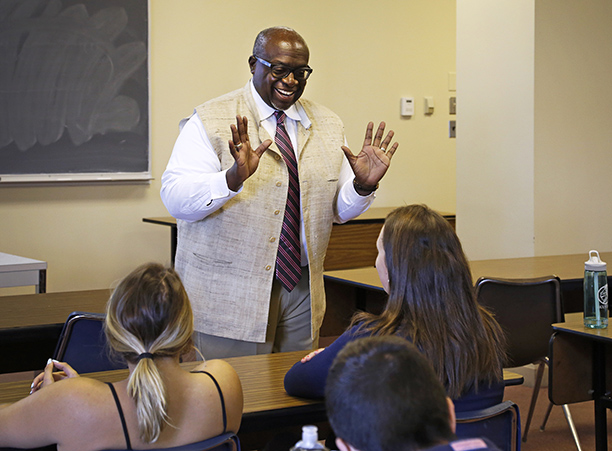Harry K. Thomas Jr. ’78, who recently left his post as U.S. Ambassador to the Philippines to serve as the State Department's diplomat-in-residence for the Southwest, shared his thoughts on the typhoon that swept across his home of three years in November.
---
Typhoon Haiyan struck the Philippines November 8. We knew it would arrive. We knew it would be devastating. That said, we were shocked and saddened at the devastation it wrought on the Filipinos and prayed for my fiancée Mithi, her family, and our friends and colleagues in our Embassy. It reminded us of the challenges we faced after Hurricanes Sandy and Katrina but I was heartened because I knew that the American people and the international community would act.
When the typhoon made landfall, President Aquino’s administration was responding to a Muslim-led insurgency in the south and an earthquake in the country’s center that had destroyed many historic churches, including a 400-year-old Jesuit church where we attended Easter Mass. The U.S. was assisting the democratically elected, honest-but-challenged national government respond to these crises and now massive U.S. assistance would be required for a country with inadequate infrastructure and overwhelmed local governments. We employ a “whole of government” approach to assist the Philippines that involves the entire 2,000 person U.S. Embassy, whose staff includes over 1,500 Filipinos and several hundred U.S. Special Forces and Special Operations Forces to provide assistance.
Here’s what happened in the first 24 hours:
- Charge (Acting Ambassador) Brian Goldbeck called Foreign Secretary Albert Ferreros del Rosario to offer assistance;
- Goldbeck then issued a disaster declaration to allow for an initial $100,000 donation (currently $37 million) to non-governmental organizations (normally Catholic Relief Services and World Vision);
- An Office of Foreign Disaster Assistance team visited the typhoon affected areas to prioritize U.S. assistance;
- The U.S. Pacific Command dispatched Marines stationed in Japan to assist;
- The Embassy alerted American citizens and sought to verify their safety and security;
- Peace Corps Volunteers were relocated to safe areas;
- Social and traditional media were utilized to tell the Filipinos that the U.S. would provide much needed assistance.
We are now working in concert with the Aquino Administration and the international community to provide assistance.
Meanwhile, as the crisis unfolded we saw horrific photos of Tacloban, one of the most severely hit cities. It has a special place in American hearts. It is where MacArthur “returned” in 1945 and began the liberation of the Philippines from Japan, where kids still affectionately call Americans (GI) “Joe” in memory of WWII, and where our Embassy had an outreach program last March highlighting the historic partnership between our two countries. We now know that several thousand people were killed in Tacloban, that schools and hospitals were destroyed and that babies are being born in local Catholic Churches ill equipped to care for them and we recoil at the reports of looting. I, however, ask what would you do if your children were starving and scavenging or looting was the only way you could feed your baby?
It will take years to rebuild cities and I pray that the international community continues to assist the Philippines, one of our treaty allies, one of the few developing nations that is democratic and which now has a reform minded and Jesuit educated president whose uncle (Jose Cojuangco ’55) was the first Filipino to graduate from Holy Cross.
Holy Cross Magazine will be touching base with former Ambassador Thomas as the recovery efforts in the Philippines continue. See his update on the progress of international aid in the Spring 2014 issue. 
Related News